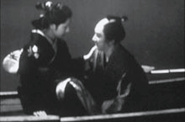In 1683 Kyoto, at the house of Ishun (Eitarô Shindô) the grand scroll maker, the printers are busy assembling the calendars for the imperial court in the absence of their senior artist, a diligent and conscientious worker named Mohei (Kazuo Hasegawa). Suffering from a lingering cold, Mohei has been working from the privacy of his room, attended to by an attractive and modest young housemaid, Otama (Yôko Minamida). Otama’s beauty has not escaped the roving eye of the master of the house and, at every given opportunity, Ishun exploits his privilege in order to proposition Otama into becoming his mistress. In an attempt to gently rebuff Ishun’s inappropriate advances (while retaining her meager employment), Otama claims to be promised in marriage to Mohei – a declaration that Ishun meets with initial skepticism. Meanwhile, Ishun’s wife, Osan (Kyôko Kagawa), encumbered with her family’s entreaties to borrow money from her husband in order to settle her irresponsible brother, Doki’s (Haruo Tanaka) debts, seeks assistance from Mohei in an attempt to mitigate her mounting financial obligation to her calculating husband. In order to raise the money, Mohei devises a plan to use Ishun’s blank official seal in order to borrow five kans of silver from the treasury with the intention of replacing the money expeditiously, but is interrupted by a co-worker who attempts to coerce Mohei into withdrawing an additional sum from the dubious transaction. Unwilling to yield to extortion, Mohei decides to reveal his intent to Ishun in the hopes of gaining sympathy, but is met with violence and threats of prosecution by a vengeful Ishun who believes that Mohei’s actions were motivated by his intent to redeem Otama from the household, and consequently, his oppressive control. Fearing arrest and determined to keep his promise of financial support to Osan, Mohei decides to escape detention and flee from the daimyo.
Adapted from the bunraku play by Genroku-era (1688-1703) dramatist, Monzaemon Chikamatsu, Crucified Lovers is a spare, evocative, and haunting portrait on the tragedy of love, duty, honor, and conformity in repressive society. By retaining the interiority and restrictive movement of jojuri puppet theater (visually emphasized through Mizoguchi’s familiar elements of rectangular compositions and movement along the diagonal of the screen), Kenji Mizoguchi captures the pervasive sense of confinement and rigidity of social conduct ingrained in Japanese culture. Initially presenting Osan, Otama, and Mohei through parallel interior shots of Ishun’s feudal estate, Mizoguchi illustrates their metaphoric – and inescapable – bounds of gender and socio-economic class: Osan’s framing against window bars as Doki pays a visit that cuts to an image of a homebound, recuperating Mohei visited by Otama in a small, upper storey room enclosed by shoji screens, then cuts back to Osan, now listening to the ingratiating entreaties of her mother to curry favor from Ishun in order to save the family’s reputation. Mizoguchi further confines the action of the first part of the film to predominantly interior locations (with the notable exceptions of Ishun’s entrance through an escorted cab, and a subsequent crane shot of anonymous, disgraced lovers paraded through the street on the way to their public crucifixion) in order to contrast the subsequent “liberation” of Mohei and Osan as they flee to Kyoto, and eventually, to the rural countryside (visually distilled into the ethereality of Mohei and Osan’s boat drifting down the river). By reflecting the figurative captivity and marginalization innate in a stratified class structure and accepted hypocrisy of the objectified role of women in society, Crucified Lovers serves as a sublime and provocative testament to the cultural legacy of codified behavior and tolerated inhumanity.
© Acquarello 2003. All rights reserved.
